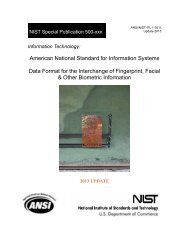ANSI/NIST-ITL 1-2011 - NIST Visual Image Processing Group ...
ANSI/NIST-ITL 1-2011 - NIST Visual Image Processing Group ...
ANSI/NIST-ITL 1-2011 - NIST Visual Image Processing Group ...
- No tags were found...
You also want an ePaper? Increase the reach of your titles
YUMPU automatically turns print PDFs into web optimized ePapers that Google loves.
<strong>ANSI</strong>/<strong>NIST</strong>-<strong>ITL</strong> 1-<strong>2011</strong>11Data Format for the Interchange of Biometric and Forensic Information5.2 Scanner resolution requirementFriction ridge images to be exchanged shall be captured by an AFIS, live-scanreader, or other image capture devices operating at a nominal scanningresolution of at least 500 ppi.Latent prints shall have a recorded scanning resolution of at least 1000 ppi.The recommended migration path to higher scanning resolutions for imagecapturing devices with a native scanning resolution of 19.69 ppmm (500 ppi)shall be at a rate of 100% of the current native scanning resolution. Therecommended migration path progresses from 19.69 ppmm to 39.37 ppmm (500ppi to 1000 ppi), from 39.37 ppmm to 78.74 ppmm (1000 ppi to 2000 ppi), etc.Capture devices with native scanning resolutions not in step with this migrationpath are required to provide (through subsampling, scaling, or interpolatingdownward) an effective scanning resolution that matches the next lower intervalin the migration path. For example a device with native scanning resolution of47.24 ppmm (1200 ppi) is required to provide an effective resolution of 39.37ppmm (1000 ppi).5.3 Transmitting resolution requirementEach image to be exchanged shall have a specific resolution associated with thetransmitted data. This transmitting resolution does not have to be the same asthe scanning resolution. However, the transmitting resolution shall be within therange of permissible resolution values for that record type. When an image iscaptured at a scanning resolution greater than the permissible upper limit of thetransmitting resolution for that record type, the image shall be subsampled,scaled, or interpolated down. This processing to reduce the scanning resolutionto a lower effective resolution must be performed before the transmission occurs.<strong>Processing</strong> to increase the resolution above scanning resolution is not permitted.For Record Type-4, the transmitting resolution shall be the same as the minimumscanning resolution of 19.69 ppmm (500 ppi.) Any recorded transmittingresolution within the range of 19.69 ppmm (500 ppi) to 20.47 ppmm (520 ppi) ispermitted for the processing of Type-4 records. If images are scanned at greaterthan 500 ppi and Record Type-4 is used, they must be transmitted at 500 ppi.Users are highly encouraged to use Record Type-14 for any images scanned atgreater than 500 ppi.For variable-resolution images, the recorded transmitting resolution is notspecified, but must be at least as great as 19.69 ppmm. There is no upper limiton the variable-resolution rate for transmission. However, the transmittingresolution shall not be greater than the scanning resolution.The recommended migration path to higher transmitting resolutions is the sameas for the scanning resolutions. That is, to progress from 19.69 ppmm to 39.37ppmm (500 ppi to 1000 ppi), from 39.37 ppmm to 78.74 ppmm (1000 ppi to 2000ppi), etc. For images captured at a native scanning resolution greater than theDRAFT 2Brad Wing 6/19/10 5:07 PMComment: Note removal of references todeprecated records. Note that Type 4 is nowREQUIRED to transmit at 500ppi as opposed to‘preferred’Brad Wing 6/19/10 5:07 PMComment: Note the encouragement to useRecord Type-14.Brad Wing 6/19/10 5:07 PMComment: Note this new restriction.
















